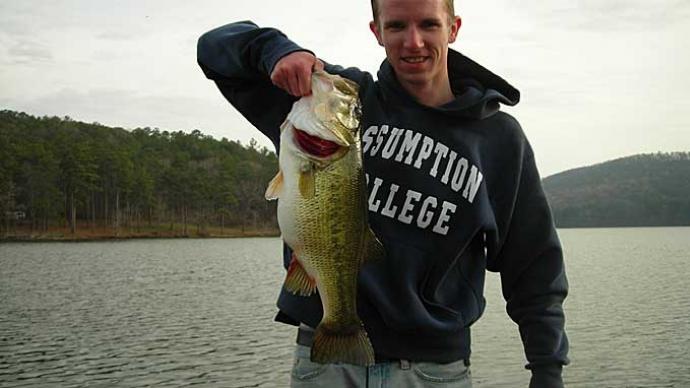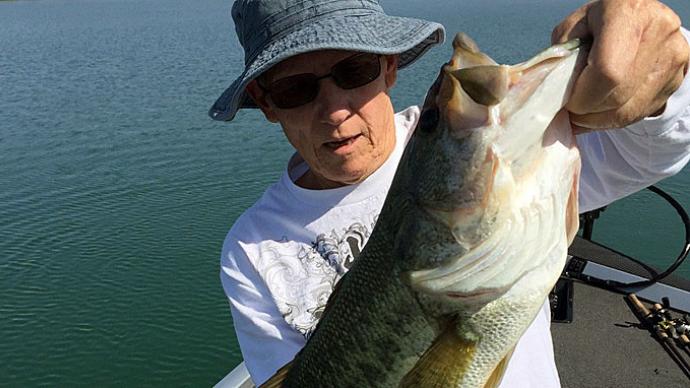
No one, even the best professional bass anglers, can tell you a specific formula for catching a really huge bass. I can't either, but what I can do is give you some sound advice that will tip the odds in your favor.
First, it is essential that you fish where bass grow to a tremendous size. Lakes like Fork (Texas), Sam Rayburn (Texas), Lake Amistad (Texas), Lake Falcon (Texas), Eufaula (Georgia, Alabama) Seminole (Florida), Toledo Bend, Caney (Louisiana) and the phosphate pit lakes in Florida and southern California all hold bass of true trophy size. Of course I didn't mention all of the lakes known for producing 10-pound plus bass. There are a large number of lakes in other states that have huge bass. It doesn't even have to be a lake to contain a monster wall-hanger. Small stock ponds produce trophies, too. It does make it easier if you fish takes that have Florida strain largemouth in them. As real estate people are fond of saying, "Location, location, location!"
The absolute surefire way of increasing your chances in any place is to fish in the spring. Fish early, stay with it, fish hard, wisely and use big-bass lures. The single most important tip of all is to fish February through May. If you look at all the state records you will find most of the trophy bass were caught during these months.
The reason for the record class trophy catches can be explained by thinking biologically. A huge fish, that somehow escaped capture until it reaches trophy size, becomes vulnerable when the mating urge hits.
A spinning centrifuge sends particles to the outside and in a similar fashion the spawning urge sends bass in large numbers to the shallows. Bass behavior during spring is triggered primarily by the angle of light, although weather conditions, temperature of the water, bottom composition and even the area of the lake affect pre-spawn movements. As the water warms and the angle of the sun moves up in the Northern Hemisphere, hormones are released within the fish which causes a general movement toward the spawning grounds.
Many believe as the weather temperature reaches 60 degrees the females will begin to move, but it is the increasing angle of light that triggers the hormonal surge that initiates pre-spawning movement.
The environmental force that drives the will to reproduce in most animals is the angle of sunlight. For instance, deer in Texas have a longer breeding season than those in Michigan do. It is nature's way of ensuring that the young will be delivered during a time in which the food source is most abundant.
In an aquatic environment, bass usually spawn first. Prey species starting with microorganisms to bream and shad begin to reproduce afterwards, thus ensuring an adequate, food supply for the young predators.
Successful reproductive activity, regardless of the species, depends on massive production in the aquatic environment. A large female may deposit 5,000 to 10,000 eggs in a male's nest and she may not be the only female that spawns in that nest. Regardless of how many eggs are deposited, 10 percent or less of the fry will survive to reach fingerling size. Of these only a few live long enough to reach adulthood. Since so few reach adulthood, one can easily see that even fewer reach true trophy size. This is one of the reasons for a catch and release policy. If you keep five- to eight-pounders, they will not grow to 10 plus.
These fish will move into shallow protected areas, which benefit from the warmth of penetrating sunlight. Sunlight and warmth are vital to the incubation of eggs and a successful hatch of fry. Once water reaches a sustained temperature of 62 to 65 degrees, most bass will begin to spawn. After all, the family name Centrarachidae means sunfish.
One should not expect all bass in the lake's population to spawn at the same time. Even within a particular lake, there will be a part of the bass population that will spawn before others in different areas. However, the peak spawning activity generally occurs during a period of about a week, during the full moon in the month in which the water temperature reaches the optimum level.
With only a few trophy size bass in a particular lake one should fish often, hard, and wisely in the most vulnerable time. That time is during pre-spawn and spawn, when hormones override caution and expose the trophy fish to the shallow-water angler.
There are a few lures that are true "big fish" lures. Most professional anglers will acknowledge the jig and pig as a lure that will consistently produce large fish. Buzzbaits and large spinnerbaits also account for a good number of spring trophies.
Later on, or on real warming periods, a Zara Spook or the Spit 'N' Image worked over a bedding bass may provoke a strike. Soft plastic lizards, tube lures and other small soft plastic lures fished on light spinning gear with 10-pound test line or smaller are used by successful anglers every year on clear lakes to take trophy class bass. With the newer smoother drags on reels and better rods, an educated angler can land much larger bass than the line pound test indicates.
Other than fishing where there are 10-pound plus bass, using good equipment during the major pre-spawn and spawning times, there is still the element of luck.
Some anglers, even those that are much more experienced than I am, don't believe taking a trophy is a matter of luck. It may not be, but if a blind hog roots long enough it will find an acorn. An accident of fate determines the size of the acorn.
Catching the bass is one thing. Killing it is another. Most fishing biologist will tell you huge bass are like diamonds. However, some say no harm occurs from fishing the beds during the spawn. But to disrupt the spawn by keeping large female bass confined and stressed in a live well is not a good way, in my opinion, to keep superior genes in the population. Measure the girth, length, photograph it and release her promptly and you will be secure in the knowledge that you have done something that most anglers can only dream about.




